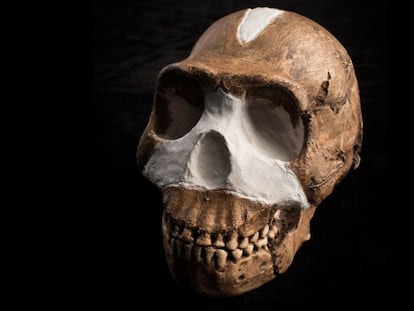The mesoamerican gods are back with a decolonialized, feminist, and queer perspective
Mexican artist Naomi Rincón Gallardo exhibits her ‘Tzitzimime Trilogy’ at La Casa Encendida in Madrid. The three audiovisual works draw on mythological tradition to address issues such as the destruction of the environment and gender identity
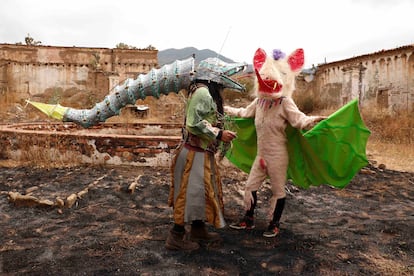
Some of the creatures that star in Naomi Rincón Gallardo’s films have blood dripping from their legs. They wear necklaces with hands, livers, and hearts hanging from them. There are disembodied arms that sprout from the earth like wriggling worms and rough-backed lizards. Two-headed snakes and strange black birds. But these are not horror, sci-fi, or superhero films. This Mexican creator’s films are audiovisual works of art inspired by opulent traditional Mesoamerican legends. The three that can be seen at La Casa Encendida in Madrid accompanied by masks and drawings — Versos de porquería (Verses of filth), Soneto de alimañas (Bloodsucker’s sonnet) and Eclipse —make up the Trilogía Tzitzimime (Tzitzimime Trilogy), which takes its name from the female deities of Mexican mythology that presage the end of time. Loaded with a decolonialized, queer, and feminist message, the exhibition is part of the annual Reivindicar la resiliencia (Reclaiming Resilience) exhibition, curated by the Lithuanian artist duo Pakui Hardware, and can be seen until September 17.
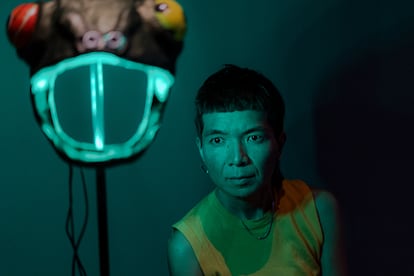
With their stark, terrifying appearance, both cadaverous and ferocious, the Tzitzimime were assimilated in the viceregal era as demons or beings from the underworld. But, in reality, as Rincón Gallardo explains, their original nature is not necessarily punitive. Rather, this vision arose as a result of the influence of Catholicism. “That’s the reading that has been imposed,” she stresses. “The Spanish conquered Mexico and tried to interpret the cultures, but I think it is a mistake to do it from the binary logic of punishment and redemption.” The idea encapsulated in it — of transcending the binarisms of black and white, man and woman, that govern Western thinking — is the key that unlocks the multiple visions in this artist’s works. Her pieces were shown at the Mexican Pavilion at the last Venice Biennial. “There is an attempt to challenge this imposed modern colonial thinking,” she adds, “to destabilize the symbolic orders of colonialism. Through the Tzitzimimes we can believe that we are in a moment of planetary collapse, a cataclysm. These are characters that I have been given to tell multiple stories from the land I inhabit, which is the land of Mexico. For over 15 years it has become a place that has accumulated many stories of violence, pain, injustice and different forms of war and necropolitics.”
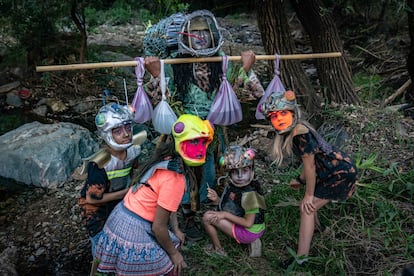
Although the three films in the exhibition make up a trilogy, each of them can be viewed independently of the others. “But there are recurring elements,” the author notes. And she elaborates: “All three have a very intimate relationship with death, with the idea that the dead can return, of the untamed dead, who wants to resurface because they have unfinished business. So, in all three, we are going to see the disembodied arms rising from the earth. It is a character from the horror of the dead cinema that has yet to return to stake a claim. And here the arms multiply, and let’s say that they refuse to accept this necropolitical or premature death. In all three, there are characters inspired by different Mesoamerican myths, which appear in the codices. For some time now I have been very interested in Mesoamerican understanding. I think it can transcend the binary logic of modern knowledge. All three films show animals that were related to the Mesoamerican underworld, creatures of the night. And all three also allude to voracious female deities.”
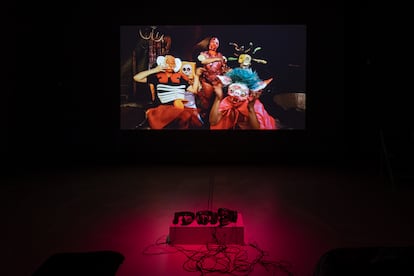
Through these referents, coated in “do it yourself” punk aesthetics, the vibrant colors that define Mexican aesthetics and a surrealistic and ironic sense of humor, the artist addresses issues such as the insatiable exploitation of the earth’s resources, the virulent imposition of the laws of heteropatriarchy, and the crushing of all types of dissidence. And not only does it confront them, but it also wants to offer a counterproposal that looks to the past, to ancestral traditions to generate groundbreaking contemporary visions. “Art has no obligation, but as an artist, a feminist, a queer subject, as someone who wants to join in destabilizing the orders of coloniality, that is my imperative.” It is precisely for this reason that she does not believe that exhibiting her work in Spain has an important connotation. “I don’t believe in these ideas of nation-states, but I think my work can resonate with different dissenting thoughts. And that’s what interests me.”
Sign up for our weekly newsletter to get more English-language news coverage from EL PAÍS USA Edition
Tu suscripción se está usando en otro dispositivo
¿Quieres añadir otro usuario a tu suscripción?
Si continúas leyendo en este dispositivo, no se podrá leer en el otro.
FlechaTu suscripción se está usando en otro dispositivo y solo puedes acceder a EL PAÍS desde un dispositivo a la vez.
Si quieres compartir tu cuenta, cambia tu suscripción a la modalidad Premium, así podrás añadir otro usuario. Cada uno accederá con su propia cuenta de email, lo que os permitirá personalizar vuestra experiencia en EL PAÍS.
¿Tienes una suscripción de empresa? Accede aquí para contratar más cuentas.
En el caso de no saber quién está usando tu cuenta, te recomendamos cambiar tu contraseña aquí.
Si decides continuar compartiendo tu cuenta, este mensaje se mostrará en tu dispositivo y en el de la otra persona que está usando tu cuenta de forma indefinida, afectando a tu experiencia de lectura. Puedes consultar aquí los términos y condiciones de la suscripción digital.
More information
Archived In
Últimas noticias
Most viewed
- Reinhard Genzel, Nobel laureate in physics: ‘One-minute videos will never give you the truth’
- Oona Chaplin: ‘I told James Cameron that I was living in a treehouse and starting a permaculture project with a friend’
- Pablo Escobar’s hippos: A serious environmental problem, 40 years on
- Chevy Chase, the beloved comedian who was a monster off camera: ‘Not everyone hated him, just the people who’ve worked with him’
- Why we lost the habit of sleeping in two segments and how that changed our sense of time


